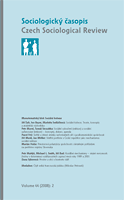Vnitřní periferie v České republice jako mechanismus sociální exkluze
Inner Peripheries of the Czech Republic as a Mechanism of Social Exclusion
Author(s): Jan Müller, Jiří MusilSubject(s): Social Sciences
Published by: AV ČR - Akademie věd České republiky - Sociologický ústav
Keywords: social space; inner peripheries; social exclusion; cumulative circular causation; Czech Republic
Summary/Abstract: Peripheral regions are most often described in terms of economic geography. However, this study stresses more the sociological aspects of peripheries, studying not only the causes, but also the social effects of life in peripheral regions. The authors use the term ‘inner peripheries’ because most of the peripheral regions detected in their analyses are located in the inner parts of the country, mainly along the borders of the administrative regions (kraje). Their approach combines the concept of the life world (espace vécu) as defined by A. Frémont and A. Giddens when describing the social and cultural consequences of living in peripheries, and a modified version of G. Myrdal´s theory of cumulative circular causation when trying to explain the origin and growth of peripheries. In the Czech Republic inner peripheries are usually the peripheral zones of metropolitan areas and regional centre areas. In the mid-1990s population numbers stopped declining in some peripheries as a result of suburbanisation processes, but in other peripheries depopulation processes continued. This last category of inner peripheries can be described as the hard core of Czech peripheral regions and in the authors’ opinion they warrant the development of specific regional policy measures, stressing the creation of new jobs, the improvement of public transport, greater accessibility of service centres, and co-operation among communities.
Journal: Sociologický časopis / Czech Sociological Review
- Issue Year: 44/2008
- Issue No: 02
- Page Range: 321-348
- Page Count: 28
- Language: Czech

